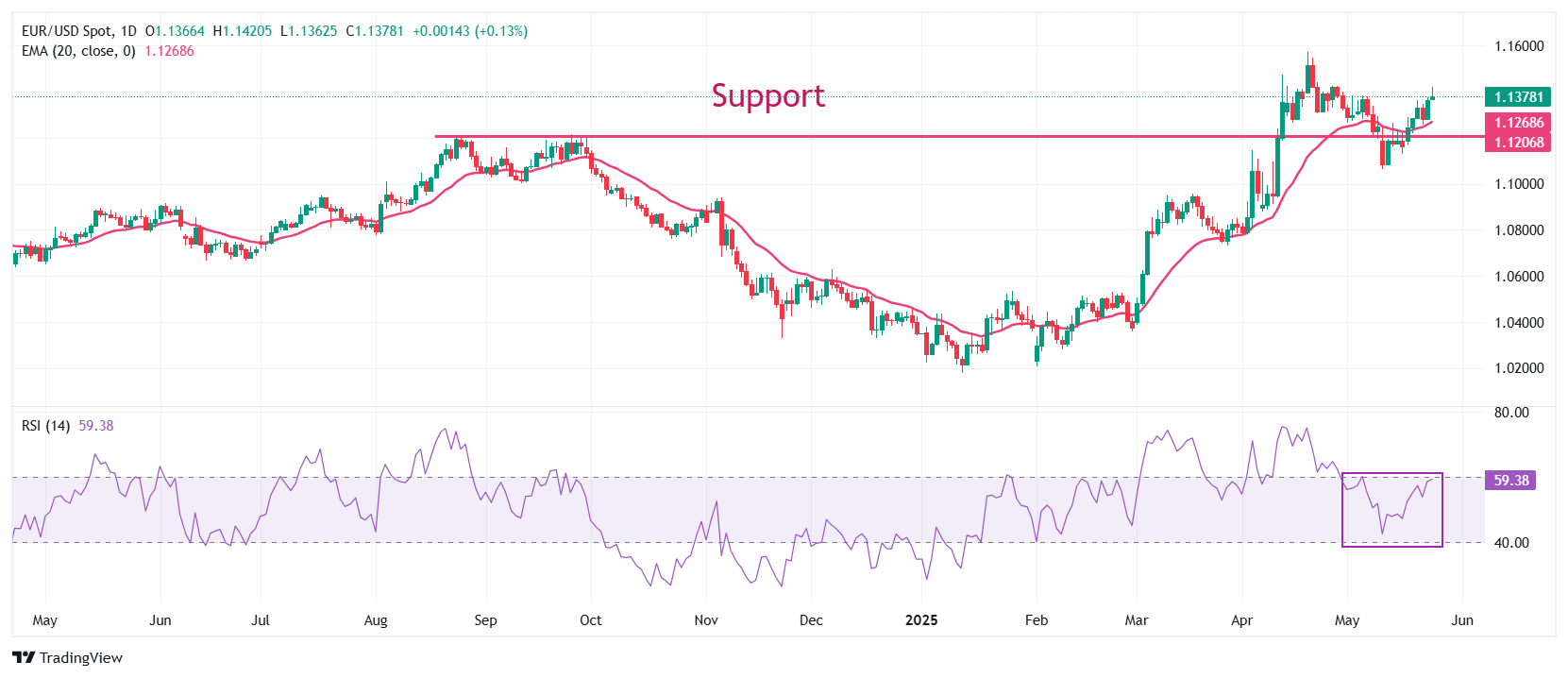EUR/USD gives back initial gains as US Dollar bounces back

- EUR/USD surrenders some of its early gains as the US Dollar recoups its initial losses.
- Trump’s erratic policy announcements have renewed concerns over the USD’s credibility.
- According to revised estimates, the German economy rose at a robust pace of 0.4% in the first quarter of the year.
EUR/USD gives up a majority of intraday gains and drops to near 1.1375 during European trading hours on Monday from the monthly high of 1.1425 posted earlier in the day. The major currency pair surrenders gains as the US Dollar (USD) claws back significant initial losses, with the US Dollar Index (DXY) rebounding to near 99.00.
However, the outlook of the US Dollar remains uncertain as erratic statements from Washington regarding tariff policies have renewed concerns over its credibility.
Over the weekend, Trump suspended his decision to impose flat 50% tariffs on the European Union (EU) until July 9, after the old continent agreed to advance trade negotiations quickly and urged for some time to reach a good deal.
European Commission President Ursula von der Leyen said in a post on X on Sunday that she had a “good” phone call with Trump and that the EU was ready to “advance talks swiftly and decisively.” “To reach a good deal, we would need the time until July 9,” she added.
On Friday, US President Trump threatened to impose 50% tariffs on imports from the EU in a post on Truth.Social, which were expected to come into effect on June 1. “Our discussions with them are going nowhere! Therefore, I am recommending a straight 50% tariff on the European Union, starting on June 1, 2025,” Trump wrote.
A quick de-escalation in trade tensions between economies situated on both sides of the Atlantic has provided relief to their equity markets and the Euro (EUR), but has put the credibility of the US Dollar under suspicion again.
The Greenback has substantially suffered in past few months as events such as ever-changing Trump’s tariff policies, threats to remove Federal Reserve’s (Fed) Chair Jerome Powell and a new tax cut and spending bill that is expected to increase already ballooning nation’s debt by $3.8 trillion have dampened USD’s safe-haven appeal. Increasing doubts over the Greenback’s credibility have also increased the Euro’s appeal. “We think the euro is continuing to benefit from being the most liquid alternative to the dollar,” ING said.
Daily digest market movers: EUR/USD trades slightly higher on strong German Q1 GDP data
- Signs of strength in the domestic region have also benefited the Euro, besides being an alternative to the US Dollar, and the rising hopes of a potential EU-US trade deal. The major currency gains as revised Q1 German Gross Domestic Product (GDP) data showed that the economy grew at a faster pace of 0.4%, compared to the preliminary estimates and the prior release of 0.2%.
- Upbeat German Q1 GDP data has diminished fears of an economic contraction on a yearly basis after declining for two straight years. Analysts at Deutsche Bank Research stated upbeat Q1 GDP figures indicate that the German economy has gained enough momentum to avoid stagnation this year. Experts guided that the economy would continue the positive trend in the second half of the year despite the potential impact of Trump’s tariff policy.
- On the monetary policy front, European Central Bank (ECB) officials have expressed optimism that inflationary pressures could return to the 2% target this year, due to which traders have remained increasingly confident that the central bank will cut interest rates again in June’s meeting.
- The comments from ECB policymaker and Governor of the Bank of Greece Yannis Stournaras, published in a Greek news media on Friday, indicated that he is comfortable with traders’ dovish bets for the policy meeting in June. “I expect one more interest rate cut in June and then a pause,” Stournaras said.
- This week, the EUR/USD pair will be influenced by the US Personal Consumption Expenditure Price index (PCE) data for April and the Harmonized Index of Consumer Prices (HICP) data from major countries of the EU for May, which will be published on Friday.
Technical Analysis: EUR/USD holds key 20-day EMA
EUR/USD posts a fresh almost a month high near 1.1420 at the start of the week. The near-term outlook of the pair is bullish as it holds the 20-day Exponential Moving Average (EMA), which is around 1.1270.
The 14-period Relative Strength Index (RSI) rises to near 60.00. Bulls would come into action if the RSI breaks above the 60.00 level.
Looking up, the April 21 high of 1.1475 will be the major resistance for the pair. Conversely, the September 25 high of 1.1215 will be a key support for the Euro bulls.
Economic Indicator
Gross Domestic Product (QoQ)
The Gross Domestic Product released by the Statistisches Bundesamt Deutschland is a measure of the total value of all goods and services produced by Germany. The GDP is considered as a broad measure of the German economic activity and health. A high reading or a better than expected number has a positive effect on the EUR, while a falling trend is seen as negative (or bearish).
